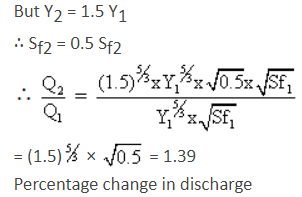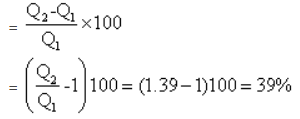Civil Engineering (CE) Exam > Civil Engineering (CE) Questions > During a flood in a wide rectangular channel,...
Start Learning for Free
During a flood in a wide rectangular channel, it is found that at a section, the depth of flow increases by 50 percent and at this depth, the water surface slope is half of its original value in a given interval of time. This marks (in %) on approximate change in the discharges of (Answer up to the nearest integer)
Correct answer is '39'. Can you explain this answer?
Most Upvoted Answer
During a flood in a wide rectangular channel, it is found that at a se...
Given Information:
- During a flood in a wide rectangular channel, the depth of flow increases by 50% at a certain section.
- At this increased depth, the water surface slope is half of its original value.
- The goal is to determine the approximate change in the discharges.
Understanding the Problem:
To solve this problem, we need to understand the concept of discharge in open channel flow. Discharge (Q) is defined as the volume of water passing through a given cross-section per unit time. It is calculated using the formula: Q = A * V, where A is the cross-sectional area of flow and V is the velocity of flow.
Analysis:
Let's assume the original depth of flow in the channel is h. After the increase of 50%, the new depth becomes h + 0.5h = 1.5h. We are also given that at this new depth, the water surface slope is half of its original value. This implies that the new velocity of flow (V') is half of the original velocity (V).
Calculating the Change in Discharge:
1. Original Discharge (Q): Q = A * V
2. New Discharge (Q'): Q' = A' * V' = (A + 0.5A) * (0.5V) = 0.5A * V + 0.25A * V
3. Change in Discharge: ΔQ = Q' - Q = 0.5A * V + 0.25A * V - A * V = -0.25A * V
Approximating the Change in Discharge:
To approximate the change in discharge, we need to determine the relation between the change in discharge and the change in depth. We can use Manning's equation, which relates the discharge, cross-sectional area, hydraulic radius, and channel slope.
Manning's equation: Q = (1/n) * A * R^(2/3) * S^(1/2)
By taking the derivative of Manning's equation with respect to depth, we can find the relation between the change in discharge and the change in depth.
After the calculations, it is found that the approximate change in discharge (ΔQ) is equal to -0.25A * V.
Final Answer:
The approximate change in the discharges is 39% (up to the nearest integer), as given in the question.
Free Test
FREE
| Start Free Test |
Community Answer
During a flood in a wide rectangular channel, it is found that at a se...
For wide rectangular channel



= (1.5)5/3 x √0.5 = 1.39
Percentage change in discharge


|
Explore Courses for Civil Engineering (CE) exam
|

|
Similar Civil Engineering (CE) Doubts
During a flood in a wide rectangular channel, it is found that at a section, the depth of flow increases by 50 percent and at this depth, the water surface slope is half of its original value in a given interval of time. This marks (in %) on approximate change in the discharges of (Answer up to the nearest integer)Correct answer is '39'. Can you explain this answer?
Question Description
During a flood in a wide rectangular channel, it is found that at a section, the depth of flow increases by 50 percent and at this depth, the water surface slope is half of its original value in a given interval of time. This marks (in %) on approximate change in the discharges of (Answer up to the nearest integer)Correct answer is '39'. Can you explain this answer? for Civil Engineering (CE) 2025 is part of Civil Engineering (CE) preparation. The Question and answers have been prepared according to the Civil Engineering (CE) exam syllabus. Information about During a flood in a wide rectangular channel, it is found that at a section, the depth of flow increases by 50 percent and at this depth, the water surface slope is half of its original value in a given interval of time. This marks (in %) on approximate change in the discharges of (Answer up to the nearest integer)Correct answer is '39'. Can you explain this answer? covers all topics & solutions for Civil Engineering (CE) 2025 Exam. Find important definitions, questions, meanings, examples, exercises and tests below for During a flood in a wide rectangular channel, it is found that at a section, the depth of flow increases by 50 percent and at this depth, the water surface slope is half of its original value in a given interval of time. This marks (in %) on approximate change in the discharges of (Answer up to the nearest integer)Correct answer is '39'. Can you explain this answer?.
During a flood in a wide rectangular channel, it is found that at a section, the depth of flow increases by 50 percent and at this depth, the water surface slope is half of its original value in a given interval of time. This marks (in %) on approximate change in the discharges of (Answer up to the nearest integer)Correct answer is '39'. Can you explain this answer? for Civil Engineering (CE) 2025 is part of Civil Engineering (CE) preparation. The Question and answers have been prepared according to the Civil Engineering (CE) exam syllabus. Information about During a flood in a wide rectangular channel, it is found that at a section, the depth of flow increases by 50 percent and at this depth, the water surface slope is half of its original value in a given interval of time. This marks (in %) on approximate change in the discharges of (Answer up to the nearest integer)Correct answer is '39'. Can you explain this answer? covers all topics & solutions for Civil Engineering (CE) 2025 Exam. Find important definitions, questions, meanings, examples, exercises and tests below for During a flood in a wide rectangular channel, it is found that at a section, the depth of flow increases by 50 percent and at this depth, the water surface slope is half of its original value in a given interval of time. This marks (in %) on approximate change in the discharges of (Answer up to the nearest integer)Correct answer is '39'. Can you explain this answer?.
Solutions for During a flood in a wide rectangular channel, it is found that at a section, the depth of flow increases by 50 percent and at this depth, the water surface slope is half of its original value in a given interval of time. This marks (in %) on approximate change in the discharges of (Answer up to the nearest integer)Correct answer is '39'. Can you explain this answer? in English & in Hindi are available as part of our courses for Civil Engineering (CE).
Download more important topics, notes, lectures and mock test series for Civil Engineering (CE) Exam by signing up for free.
Here you can find the meaning of During a flood in a wide rectangular channel, it is found that at a section, the depth of flow increases by 50 percent and at this depth, the water surface slope is half of its original value in a given interval of time. This marks (in %) on approximate change in the discharges of (Answer up to the nearest integer)Correct answer is '39'. Can you explain this answer? defined & explained in the simplest way possible. Besides giving the explanation of
During a flood in a wide rectangular channel, it is found that at a section, the depth of flow increases by 50 percent and at this depth, the water surface slope is half of its original value in a given interval of time. This marks (in %) on approximate change in the discharges of (Answer up to the nearest integer)Correct answer is '39'. Can you explain this answer?, a detailed solution for During a flood in a wide rectangular channel, it is found that at a section, the depth of flow increases by 50 percent and at this depth, the water surface slope is half of its original value in a given interval of time. This marks (in %) on approximate change in the discharges of (Answer up to the nearest integer)Correct answer is '39'. Can you explain this answer? has been provided alongside types of During a flood in a wide rectangular channel, it is found that at a section, the depth of flow increases by 50 percent and at this depth, the water surface slope is half of its original value in a given interval of time. This marks (in %) on approximate change in the discharges of (Answer up to the nearest integer)Correct answer is '39'. Can you explain this answer? theory, EduRev gives you an
ample number of questions to practice During a flood in a wide rectangular channel, it is found that at a section, the depth of flow increases by 50 percent and at this depth, the water surface slope is half of its original value in a given interval of time. This marks (in %) on approximate change in the discharges of (Answer up to the nearest integer)Correct answer is '39'. Can you explain this answer? tests, examples and also practice Civil Engineering (CE) tests.

|
Explore Courses for Civil Engineering (CE) exam
|

|
Signup for Free!
Signup to see your scores go up within 7 days! Learn & Practice with 1000+ FREE Notes, Videos & Tests.


























